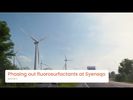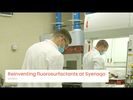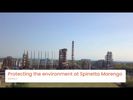Innovatie gebruiken om duurzame oplossingen te creëren
Als bedrijf van onderzoekers en innovators gebruiken we wetenschap niet alleen om nieuwe kansen en doorbraken te identificeren, maar ook om verouderde processen te verbeteren of opnieuw uit te vinden.
Onze fluorosurfactant-vrije technologieën zijn het levende bewijs van innovatie in actie. Ze gebruiken een gloednieuw polymerisatieproces dat geen fluorosurfactanten uit de PFAS-familie nodig heeft als hulpstof.
Innovatieve technologie zonder fluorosurfactanten
Bij Syensqo zijn we er trots op dat we de overgrote meerderheid van onze fluoropolymeren - materialen die nodig zijn voor batterijen van elektrische voertuigen, hybride motoren, waterstoftoepassingen, faciliteiten voor hernieuwbare energie, de productie van halfgeleiders, medische apparatuur en meer – produceren zonder het gebruik van fluorosurfactanten.
Geleid door ons Duurzaamheidsactieplan hebben we sinds 2019 onze R&D-investeringen verviervoudigd om een nieuw polymerisatieproces te ontwikkelen met behulp van onze nieuwe technologie zonder fluorosurfactanten.
Onze ambitie
Het doel van Syensqo is om het gebruik van fluorosurfactanten wereldwijd uit te faseren. Ons succes bij de ontwikkeling van technologieën zonder fluorosurfactanten in de VS, in onze vestiging in West Deptford, New Jersey, was een belangrijke stap. In Spinetta Marengo in Italië streven we ernaar tegen 2026 bijna 100% van onze fluoropolymeren te produceren zonder gebruik te maken van fluorosurfactanten.
Feiten over Syensqo en PFAS
- Syensqo heeft nooit PFOA of PFNA geproduceerd of verkocht.
- Syensqo heeft nooit PFOS gebruikt of blusschuim geproduceerd – de belangrijkste bron van bepaalde PFAS in het milieu.
- Syensqo heeft in respectievelijk 2003 en 2010 het gebruik van PFOA en PFNA in de VS vrijwillig afgebouwd en in 2013 wereldwijd het gebruik van PFOA stopgezet.
- Vandaag produceren we bij Spinetta Marengo slechts beperkte hoeveelheden van de nieuwe generatie fluorosurfactant (C6O4), terwijl we tegelijkertijd overschakelen op nieuwe fluorovrije technologie.
Bovendien maakt Syensqo in Spinetta Marengo gebruik van de nieuwste technologieën, die de uitstoot van fluoro-oppervlakteactieve stoffen met bijna 100 % elimineren.
Onze producten
Ons baanbrekende polymerisatieproces met behulp van onze nieuwe technologie zonder fluorosurfactanten maakte de ontwikkeling mogelijk van een eerste portfolio fluorelastomeren en perfluorelastomeren van de merknaam Tecnoflon® evenals Aquivion® G+ NFS, een fluoro-ionomeer van de volgende generatie ontworpen voor schone energie en elektrochemische toepassingen.
Deze vooruitgangen zetten een nieuwe industriestandaard voor hoogwaardige materialen, ter ondersteuning van de overgang naar oplossingen zonder fluorosurfactanten in kritieke industrieën om te kunnen ingaan op de evoluerende behoeften van industrieën voor prestaties en grotere duurzaamheid.
Veelgestelde Vragen
PFAS omvat een zeer breed spectrum van stoffen, met zeer verschillende eigenschappen. Syensqo heeft geïnnoveerd om alternatieven te vinden voor PFAS-stoffen die zorgen kunnen baren, en richt zich daarom op het uitfaseren van fluorosurfactanten.
Fluoropolymeren zijn materialen die essentieel zijn voor batterijen van elektrische voertuigen, hybride motoren, waterstoftoepassingen, installaties voor hernieuwbare energie, de productie van halfgeleiders, medische apparaten en meer. Ze zijn chemisch inert, wat betekent dat ze niet-toxisch, niet bio-beschikbaar, niet wateroplosbaar en niet mobiel zijn.
Fluorsurfactanten zijn kleine, niet-polymeer moleculen die worden gebruikt bij de productie van sommige fluoropolymeren. Op onze locatie in Spinetta Marengo gebruiken we beperkte hoeveelheden van C6O4, een fluorsurfactant van de volgende generatie, die in tegenstelling tot andere fluorsurfactanten niet bioaccumuleerbaar is.
Syensqo produceert al een groot deel van onze fluorpolymeren - materialen die essentieel zijn voor batterijen van elektrische voertuigen, hybride motoren, waterstoftoepassingen, installaties voor hernieuwbare energie, halfgeleiders, medische apparatuur en meer - zonder het gebruik van fluorosurfactanten.
Op dit moment gebruiken we beperkte hoeveelheden van een fluorosurfactant van de volgende generatie - C6O4 - die niet bioaccumulatief is - als een hulpmiddel bij de ontwikkeling van bepaalde fluorpolymeren in onze productiefaciliteit in Spinetta Marengo. C6O4 is geregistreerd in overeenstemming met REACH (de verordening van de Europese Unie voor Registratie, Evaluatie, Autorisatie en Beperking van Chemicaliën) en is goedgekeurd door de EFSA (Europese Autoriteit voor Voedselveiligheid). In deze fabriek passen we geavanceerde technieken toe die bijna 100% van de uitstoot van fluorosurfactanten elimineren, terwijl we werken aan de overgang van deze fabriek naar technologieën zonder fluorosurfactanten tegen 2026.
We hebben vijf productielocaties waar fluorpolymeren worden gemaakt, en slechts één locatie waar nog een fluorsurfactant wordt gebruikt. We zijn van plan dit tegen 2026 volledig uit te faseren.
- Tavaux (Frankrijk) - Orange (TX, VS) - Changshu (China): Op deze drie sites maken we fluorpolymeren zonder het gebruik van fluorsurfactanten.
- West Deptford (VS): Hier stopte Syensqo in 2021 geleidelijk met het gebruik van fluorsurfactanten door de lancering van technologieën zonder fluorsurfactanten.
- Spinetta Marengo (Italië): Hier gebruiken we nog één fluorsurfactant (C6O4), een volgende generatie fluorsurfactant die voornamelijk niet bioaccumulerend is (het concentreert zich niet en hoopt zich niet op in organismen). Deze verbinding wordt niet verkocht maar in kleine hoeveelheden gebruikt als hulpmiddel bij de productie van sommige - maar niet alle - fluorpolymeren.
Syensqo heeft geïnvesteerd in de beste beschikbare technologieën om de uitstoot terug te brengen tot bijna 100%. We hebben de afgelopen jaren meer dan 60 miljoen euro geïnvesteerd in een nieuwe geavanceerde waterbehandeling technologie (omgekeerde osmose en actieve kool) om de uitstoot van gefluoreerde oppervlakteactieve stoffen te elimineren.
De site in Spinetta voldoet aan alle milieuvergunningen van de bevoegde autoriteiten en is een van de meest gecontroleerde sites in Europa, met honderden analyses die jaarlijks door de autoriteiten worden uitgevoerd.
Syensqo baseert zich op zijn eigen dataset voor het monitoren van de gezondheid van zijn werknemers (+800 mensen sinds 2004). We hebben de afgelopen 20 jaar meer dan 7.700 bloedtests uitgevoerd. Alle resultaten werden transparant en consequent gedeeld met werknemers, vakbonden en gezondheidsautoriteiten. De afdeling bedrijfsgeneeskunde voert jaarlijks gedetailleerde gezondheidscontroles uit voor elke werknemer. Deze beoordelingen hebben geen klinisch-toxicologisch effecten gerapporteerd voor de gezondheid van onze werknemers die in contact komen met fluorosurfactanten.
Nee. We hebben met succes technologieën zonder fluorosurfactanten ontwikkeld in onze fabriek in West Deptford, New Jersey en de lancering ervan in mei 2021 aangekondigd. Dit is een belangrijke stap op weg naar Syensqo's doel om het gebruik van fluorosurfactanten wereldwijd uit te bannen.
In juni 2023 bereikte de onderneming (toen nog Solvay) een akkoord met het New Jersey Department of Environmental Protection (NJDEP) over PFAS-gerelateerde claims in New Jersey. Het akkoord loste de rechtszaak van het NJDEP tegen de onderneming op zonder aansprakelijkheid toe te geven. De overeenkomst is een constructieve en tijdige manier om PFAS in het milieu te saneren, terwijl het bedrijf de kosten kan verhalen op andere bronnen van PFAS, aangezien de overeenkomst expliciet erkent dat het bedrijf het recht heeft om compensatie te vragen van dergelijke andere vervuilers. De schikking omvatte toezeggingen om saneringsactiviteiten af te ronden die het bedrijf vrijwillig was begonnen toen het hoorde dat er in 2013 PFAS in het gebied waren gedetecteerd, waaronder het testen van water en grond in de buurt van de West Deptford-locatie, en het bedrijf heeft ermee ingestemd om een financieringsbron voor sanering op te zetten voor een bedrag van $ 214 miljoen om deze activiteiten te financieren.
Aanvullende informatie over de status van Syensqo's rechtszaken is te vinden in ons laatste jaarverslag onder “Risicobeheer”.
Syensqo Tavaux produceert voornamelijk polyvinylideenfluoride (PVDF), een fluorpolymeer dat wordt gebruikt bij de productie van nieuwe generaties lithium-ionbatterijen voor hybride en elektrische voertuigen door toonaangevende batterijproducenten wereldwijd. Het portfolio omvat bindmiddelen en separatorcoatings voor Li-ioncellen die veilig en stabiel zijn, zowel elektrochemisch als thermisch, met een hoge energiedichtheid en een lange levensduur.
De site van Syensqo in Tavaux gebruikt en produceert geen fluorosurfactanten, de PFAS-stoffen die in de kijker staan en opgenomen zijn in de Europese richtlijn inzake water bestemd voor menselijke consumptie.













